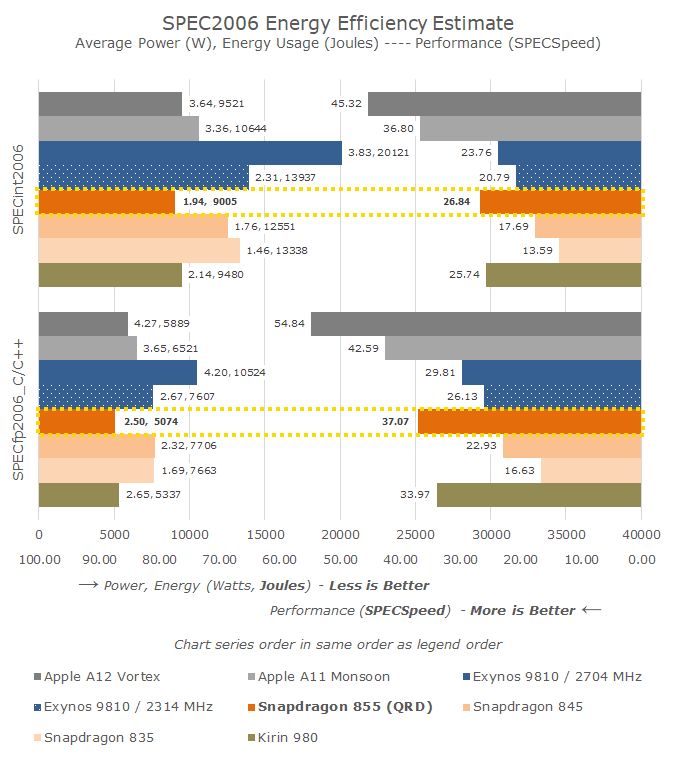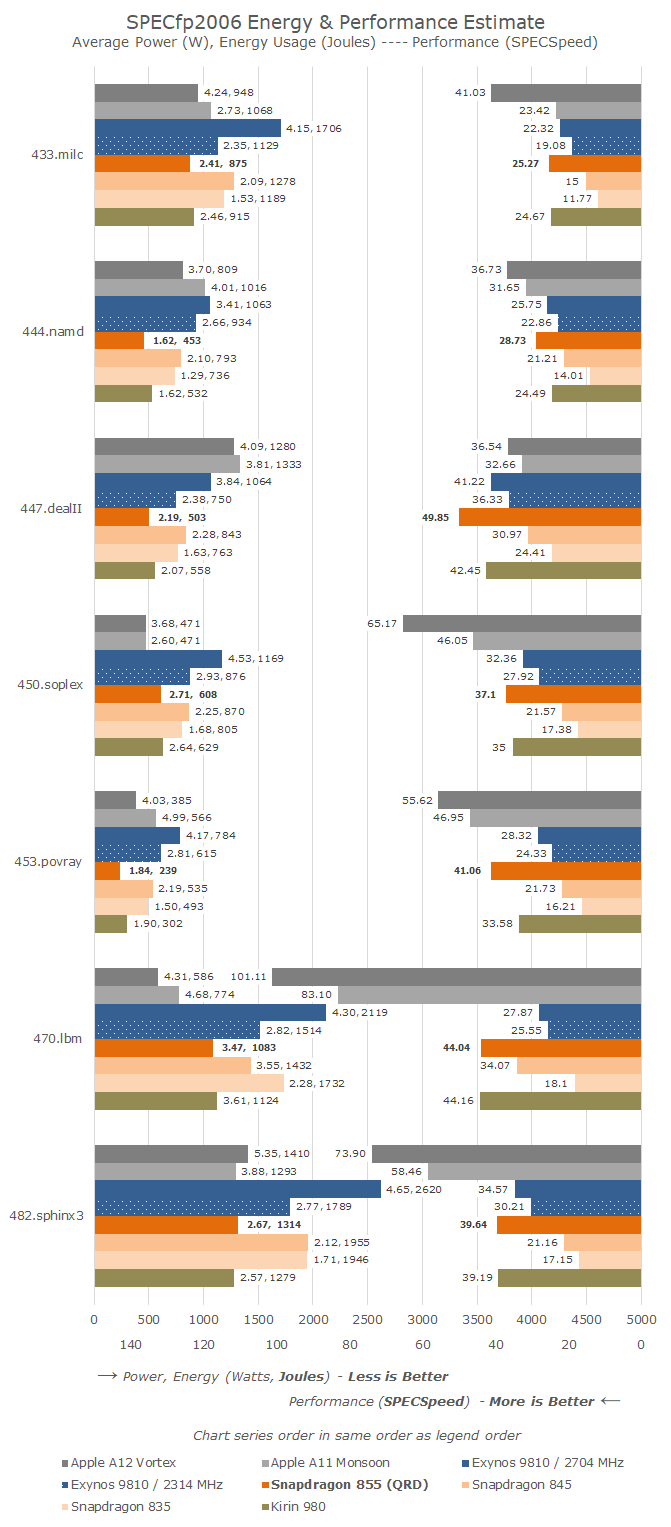The Snapdragon 855 Performance Preview: Setting the Stage for Flagship Android 2019
by Andrei Frumusanu on January 15, 2019 8:00 AM EST- Posted in
- Mobile
- Qualcomm
- Smartphones
- SoCs
- 7nm
- Snapdragon 855
CPU Performance & Efficiency: SPEC2006
We move on with our analysis by using SPEC2006 on the Snapdragon 855 QRD. SPEC2006 is an important benchmark as not only does it represent a tool that is used by many companies to architect their CPU designs, but it also a very well understood and academically documented workloads that can serve as a macro-benchmark to determine microarchitectural aspects of a CPU and system.
It’s to be noted that SPEC2006 has been deprecated in favour of SPEC2017, and although we’ll switch to that at some point, for mobile platforms SPEC2006 still represents a good benchmark. Because our scores aren’t official submissions, as per SPEC guidelines we have to declare them as internal estimates from our part.
A Big Note on Power on the QRD
Although for this article I was able to collect power figures for both CPU and GPU workloads, the figures are not of an as high certitude as when measured on commercial devices. The reason for this is that much like last year’s Snapdragon 845 QRD, this year’s 855 platform reports rather high idle power in the 950-1050mW range, about 500mW more than one would expect in a final product. Because our power measurement methodology represents publishing active system power, meaning we measure total power during a given workload and subtract the idle power under the same conditions, there is a degree of uncertainty if the idle power by default is quite high.
Today’s power efficiency figures thus merely represent a guideline – and we’ll make sure to re-test the results once we get our hands on final commercial devices.
The Results – The Snapdragon 855 Performs Admirably
We’ll start off with the aggregate results and drill down in the detailed results later:
The Snapdragon 855 ends up performing extremely well, ending up neck-and-neck with the Kirin 980’s performance, which shouldn’t come as too big of a surprise.
In SPECint2006, the Snapdragon 855 performs 51% better than the Snapdragon 845, all while improving power efficiency by 39% over its predecessor. Against the Kirin 980 which is currently its nearest Android competitor, the Snapdragon just slightly edges ahead by 4%.
In SPECfp2006, the Snapdragon 855 shows an even bigger 61% leap over the Snapdragon 845, and also manages to better showcase the 9% clock speed advantage over the Kirin 980, sporting a similar performance lead.
Again what is most important in these results is the power efficiency figures. One of the things that had me worried during Qualcomm’s Snapdragon 855 launch in Hawaii last month is that the company pretty much avoided talking or publishing any meaningful power efficiency claims on the side of the CPU. Fortunately it seems there wasn’t any need to be concerned as the Snapdragon 855, at first glance, seems to be extremely efficient even on the high clocked 2.85GHz Prime core.
Detailed Results
Drilling down into the detailed results, the one comparison that is most interesting is the performance of the Snapdragon 855 against the Kirin 980. On one hand the Snapdragon 855 is clocked 9% higher as well as promises some tuned microarchitectural characteristics which promise to improve IPC – while on the other hand HiSilicon’s implementation is more straightforward and brings with itself a bigger L3 cache as well as memory latency advantages.
In the vast majority of workloads, both chipsets are neck-and-neck, only diverging in some key aspects. In less memory hierarchy demanding workloads, the Snapdragon more easily is able to showcase its clock speed advantage. In more latency sensitive workloads, this difference shrinks or reverses. 462.libquantum is an interesting result as Qualcomm commented that its lead here is primarily due to the customisations made on the CPU core – although they wouldn’t exactly specify which aspect in particular is bringing the boost.
The biggest performance discrepancy on the negative side of things is the 13% disadvantage in 458.sjeng – the benchmark is most sensitive to branch mispredictions and again here Qualcomm has stated they’ve made changes to the branch data structures of the core.
What is most odd for me to see as a result, is the fact that 429.mcf performs admirably well on the Snapdragon 855 – which goes against intuition given the platform’s memory latency disadvantage. It is possible here that the Snapdragon 855 performs better than the Kirin 980 due to its better L3 cache latency?
On the SPECfp2006 results, the results can be very clearly categorised into two sets: In one set the Snapdragon 855 clearly showcases a healthy advantage over the Kirin 980, up to very notable 17% and 22% leads in 447.dealII and 453.povray. In the other set, the Snapdragon is again neck-and-neck with the Kirin 980, and these happen to again be the workloads that are most memory sensitive in the FP suite.
Overall, the Snapdragon 855’s CPU performance does not disappoint. Performance on average is ahead of the Kirin 980, although not by much. Here both chipsets are most of the time neck-and-neck, and it will mostly depend on the workload which of the two will take the lead.
More important than performance, the efficiency of the Snapdragon 855 is top-notch, exceeding what I had expected from the higher clock implementation of the chip. There is still a degree of uncertainty over the power numbers on the QRD platform, but if these figures are representative of commercial devices, then 2019’s flagship will see excellent battery life.














132 Comments
View All Comments
genekellyjr - Wednesday, January 16, 2019 - link
You might be clueless too! There weren't any "4k rendering" benchmarks in that link - but there were 4k encoding benchmarks.And as for that encoding performance you are apparently referencing, it is definitely using fixed function encoders - it's not the CPU performance as Geekbench tests use (and I want to stress cross-platform Geekbench isn't 1:1 scoring - you'll never find Andandtech comparing various CPU architectures with Geekbench as it even uses fixed function resources like AES in its crypto stuff). And the speeds the laptops show definitely point to a CPU encoder being used. A fixed function encoder will barely hit the CPU, while CPU encoding will max those cores at 100%. The CPU encoding is higher quality at the cost of heat and speed.
Recently Adobe updated Premier to support Intel's fixed function encoder (called quick sync) read here http://www.dvxuser.com/V6/showthread.php?362263-Ad... post #8 - and Rush may not have gotten that update yet or the benchmark site referenced didn't update their program https://www.laptopmag.com/reviews/laptops/new-ipad... but I managed to find a benchmark for the quick sync in Premier https://forums.creativecow.net/thread/335/101459 - and Intel's quick sync fixed function stuff is all relatively the same afaik so the desktop CPU has less of an impact - gives a 1:20 min 4K -> 1080p conversion at 91 sec w/ CPU and 45 sec w/ fixed function, scale that up to 12 min (x9) and we get 13:39 w/ CPU (it's a nice CPU, i7-8700K) and the fixed function encoder gets 6:45. It'll probably scale pretty linearly. So 6:45 vs 7:47 with fixed function encoding - which isn't comparing CPUs at all at this point but rather their fixed function encoder!
So the iPad has some nice hardware, sure, but it's not outperforming Intel's brand new MB Pro 13" by leaps and bounds. They'll probably be about the same speed with fixed function encoding and the MB Pro 13" will win in a non-encoder setting thanks to its increased TDP.
darkich - Friday, January 18, 2019 - link
Okay.. So in short, the A12X is "about the same" in CPU performance as Intel's actively cooled, CPU-specific and twice more power hungry chip while also having a 1+TFLOPS GPU, 4G modem and advanced ISP on the same die.Overall, if that is what you call "nice", then Intel's hardware is what?
Trash.
Rudde - Friday, January 18, 2019 - link
Let's compare Intel i7-8500Y and Apple A12X. The i7-8500Y is a dual core 5W 14nm notebook/tablet processor. A12X is a octa core 7nm tablet processor with unknown power usage. 8500Y uses the x86-64 instruction set, while A12X uses ARMv8. They have very few benchmarks in common, which introduces notable amounts of uncertainty.Let's start with Geekbench 4.1/4.2 Single threaded:
8500Y scored 4885 and A12X 4993. A12X leads with 2%, which is within margin of error.
Same benchmark, but multithreaded:
8500Y scored 8225 and A12X 17866. A12X demolishes the dual core with 117% higher performance. This is clearly because of the 4-core-cluster in A12X having double core count compared with the dual core 8500Y.
Next up we have Mozilla Kraken 1.1 showing browser performance:
8500Y scores 1822ms and A12X 609ms. The A12X took 67% less time to complete the task, which amounts to a 199% increase in performance.
Octane V2 is another browser performance benchmark:
8500Y scores 24567 and A12X 45080. A12X bests the Intel cpu by 83%.
3D Mark has two versions of Ice Storm Physics and unfortunately our processors use different versions. They use the same resolution however.
8500Y scores 25064 in standard physics and A12X 39393 in unlimited physics. A12X scores a 57% lead.
It's hard to establish system performance with such a limited amount of benchmarks. Geekbench and 3DMark are synthetics and the two others show browser performance.
The processors are equal in ST, but the A12Xs higher core count allows it to double the 8500Ys MT score. The A12X outpaces the 8500Y in 3dMark. The A12X is clearly superior in browser performance. Apples A12 drops closer to the Intel in synthetics, but performs similar to it's larger sibling in web benchmarks.
Winner: A12X
Nemaca - Tuesday, January 15, 2019 - link
Overall, the 855 was thought to be head and shoulders above Kirin, but it seems that it will be on the same level at best.I'm typing this from my already heavily used mate 20pro, so if the US wouldn't nuke Huawei global-wide right now, the Kirin would certainly push ahead, which I hope it will do, since it seems more competitive price-wise.
Huawei bypassed the power issue with larger batteries, but to be honest, the Kirin doesn't seem to be that hungry anyway.
For me, the 855 is a letdown, I was hoping for more, but it seems my mate20pro will be relevant for longer then I thought, so not too bad of a news, I guess.
Thank you, Andrei, for the in-depth review!
Achtung_BG - Wednesday, January 16, 2019 - link
Snapdragon 855 .......https://youtu.be/mqFLXayD6e8
darkich - Tuesday, January 15, 2019 - link
This here proves once and for all that your system performance benchmarks are just bogus and irrelevant.Are we seriously supposed to believe that Snapdragon actually made a lower performing chipset than their previous one?
BS
darkich - Tuesday, January 15, 2019 - link
*Qualcomm, not SnapdragonIcehawk - Tuesday, January 15, 2019 - link
It's happened before in the chase for efficiencynpp - Tuesday, January 15, 2019 - link
I really doubt we’ll see battery life improve much with this generation. Hint - 5G. Maybe that’s why 855 focuses on overall efficiency, and the GPU gains are modest. Let’s hope I’m wrong.Impulses - Tuesday, January 15, 2019 - link
Yeah, that's the big wrench in the works... Hopefully there's at least *some* flagships without 5G! Though I doubt I'll be looking for an upgrade from my Pixel 3 this year or next.